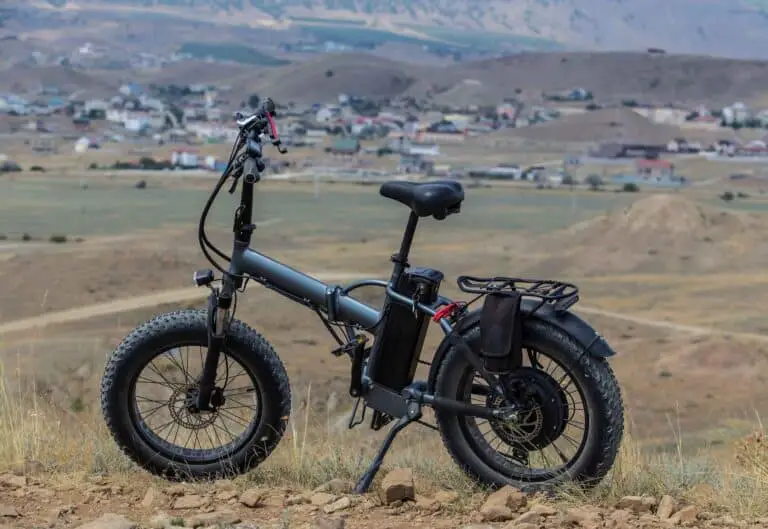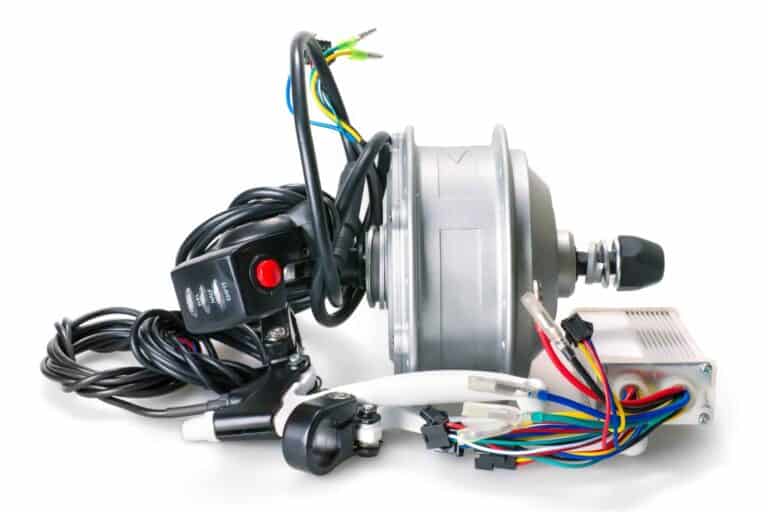Why Are Electric Bikes So Expensive (How to Get Better Deal)
Upon researching electric bikes that suit my preferences, I realized that they are more expensive than the traditional bikes. This led me to ask the question: Why are electric bikes so expensive?
As a whole, electric bikes are expensive due to to having more costly components. Unlike traditional bikes, electric bikes have a motor, battery, and added technology that makes them pricier.
In this article, we will delve into why electric bikes are expensive and address questions related to their pricing. We will also cover factors which directly impact their pricing.
Why Are Electric Bikes so Expensive?
Electric bikes are expensive due to the components that make them work. The most essential components impacting an electric bike’s price are the motor and the battery. The e-bike’s battery provides the necessary power or energy for the motor to work, and the motor is responsible for providing assistance while pedaling. With these features, electric bikes are considered environmentally friendly modes of transportation, making cycling much more effortless. They require less energy and effort to run. They can help you accelerate faster and climb hills quicker than traditional bicycles.
With an electric bike, you can minimize the hassle and effort needed to pedal. Simply turn on the battery, set the pedal-assistance level you need for your ride, and you’re good to go. Some electric bikes also allow you to ride them like a motorcycle, but this is only possible if the e-bike has a throttle. Additionally, you can ride your electric bike like a traditional bicycle when the battery is drained, or you don’t need motor assistance.
So, the price difference can be surprisingly significant when comparing the pricing of a high-quality electric bike to a high-quality traditional bicycle. The cost of a high-quality e-bike is often double or even higher than the price of a conventional bike.
Beyond the battery and motor, the electric bike’s brand, overall components, and features also significantly influence its purchase cost. Electric bikes manufactured by well-known brands featuring high-quality components and advanced technology will likely be sold at much higher prices.
Electric bikes vary in price, with cheaper e-bikes costing as low as $600, while more expensive ones may reach as high as $10,000 or even higher.
Here are some of the electric bikes you can purchase:
| Electric Bike | Cost | Battery Capacity | Range | Motor |
| RadRover 6 Plus Electric Fat Tire Bike | $1,399 | 589-672 Wh | 25-45 miles (40.2-72.4 km) per charge | 750W brushless geared hub motor |
| Sol Eclipse Electric Bike | $1,899 | 614Wh | 45 miles (72.4 km) per charge | 750W hub motor |
| Model S Electric Bike | $1949 | – | 60 miles (96.6 km) per charge | 500W (nominal)750W (peak) |
| XP Step-Thru 3.0 Foldable eBike | $999 | 500Wh | 45 miles (72.4 km) per charge | 500W (nominal)1,000W (peak) hub motor, 55Nm torque |
| Portola Folding Electric Bike | $995 | 643Wh | 20-40 miles (32.2-64.4 km) per charge | 750W geared hub motor, 65nm torque |
| Alpha Electric Bike | $1,199 | 375Wh | 15-40 miles (24.1-64.4 km) per charge | 350W rear hub motor |
| Freedom X Electric Bike | $1,198.98 | 316.8Wh | 35 miles (56.3 km) per charge | 550W Bafang or Wing custom motor, 55Nm |
| CITYPRO E-53 Electric Bike | $999 | 960Wh | 125 miles (201.2 km per charge | 500W (nominal)907W (peak) |
| Aventure 2 Electric Bike | $1799 | 720Wh | 60 miles (96.6 km) per charge | 750W rear hub motor |
Are Electric Bikes Worth the Money?
As a general rule, electric bikes are worth the money. With the advantages that electric bikes offer, they are definitely something worth investing in. Just ensure you purchase an electric bike that suits your style, needs, and preferences.
Here are some advantages that make electric bikes a worthwhile investment:
- Catering to your commute and transportation needs.
- Facilitating fitness goals and health improvement.
- Providing enhanced mobility.
- Offering assistance while pedaling.
- Serving as an environmentally friendly mode of transportation.
- Accommodating a wide range of riders
Electric Bikes Can Cater to Your Commute and Transportation Needs
An electric bike can effortlessly assist you in navigating town and running errands. It’s versatile enough to use for visiting friends or family, commuting to work, making deliveries, going on tours with friends, and more. Serving as a faster alternative to regular bikes, an electric bike enables you to reach your destination swiftly and with minimal effort.
Electric Bikes Can be Used to Maximize Fitness and Reach Health Goals
Biking is an excellent form of exercise, and some may wonder if electric bikes can provide as much of a workout as traditional bikes. The answer is yes! When it comes to working out, electric bikes and regular bikes are comparable. What electric bikes offer is an effective workout with less exhaustion on your part. Unlike traditional bicycles, where you might experience strain on your thighs and legs, electric bicycles help minimize this discomfort. Furthermore, electric bikes enable you to maximize fitness, improve cardiovascular activity, and lose weight.
There are various ways to get a good workout with your electric bike. If you’re using your e-bike for exercise and improved fitness, consider using the lowest pedal-assistance level or turning off the pedal assistance altogether to burn more calories. Another method to maximize fitness with your e-bike is by taking more challenging routes or riding on demanding terrains, requiring more energy and burning more calories. However, achieving maximum fitness doesn’t happen in one day. To maximize fitness with your e-bike, make sure to ride regularly. Establish a schedule, such as a 15-minute ride every morning or a time that suits your routine. Consistency is key. Additionally, ensure that you maintain a proper diet for overall health.
If you want to learn more about getting a good workout with your electric bike, you can read our article titled “Workout on Electric Bike (Lose Weight and Maximize Fitness).” This article will likely provide additional insights and tips on how to effectively use your electric bike for fitness purposes.
You can also watch the video below for electric biking tips to get fit.
Electric Bikes Provide Enhanced Mobility
Some people experience leg problems, making excessive pedaling inadvisable for them. What makes electric bikes perfect is that they do not require too much effort in pedaling, preventing additional strain on the legs. Some electric bikes also feature a throttle, allowing you to ride completely electric. You don’t have to pedal; you only have to press or twist the throttle.
With electric bikes, even if you have mobility issues, you’ll still be able to enjoy your electric bike ride. However, it is essential to note that it is always best to ask your health professional before riding one, as they know what’s best for you.
Electric Bikes Provide Assistance When Pedaling
Electric bikes come equipped with a battery and motor that work together for pedal assistance. These bikes typically offer various pedal-assistance levels or riding modes, allowing you to choose the level of assistance you desire from your e-bike motor. The beauty of pedal assistance lies in its ability to make cycling and pedaling significantly easier, less exhausting, and requiring minimal effort. Picture yourself cycling for an extended period—unlike traditional bicycles, where exhaustion is likely, e-bikes allow you to cover the distance with much less fatigue. Moreover, electric bikes make hill climbing a breeze, especially with a powerful motor and a high-capacity battery. This combination enables you to enjoy an extended ride across different terrains.
Electric Bikes are Eco-Friendly
Electric bikes, unlike motorcycles and cars, do not rely on gas. Instead, they utilize a motor and battery, resulting in significantly lower CO2 emissions, making them eco-friendly. In addition to helping you reach your destination, it also enables you to protect the environment.
Electric Bikes Can Accommodate Wide-Range of Riders
There are different types of electric bikes, and they are available in various sizes, colors, styles, and uses. Electric bikes are designed for commuting, mountain biking, off-roading, touring, carrying cargo, and other purposes. Depending on your needs, size, and preferences, there will be an electric bike that best suits you. For instance, if you are looking for an e-bike that can carry a heavier weight, you can check for e-bikes with a higher weight limit. You can also choose to purchase an electric cargo or utility bike because most of these types have weight capacities greater than 350 lbs (158.8 kg). If you are looking for an e-bike that is best for off-road rides, you can purchase a moped-style electric bike. These e-bikes often feature a suspension fork and a maximum speed greater than 28 mph (45 kph).
“The road might be uphill, but on an e-bike, every pedal is a thrill!”-unknown.
What Are the Disadvantages of Electric Bikes?
As a whole, purchasing an electric bike comes with several disadvantages, including:
- Electric bikes can be expensive.
- E-bikes tend to be heavier than traditional bicycles.
- The maintenance costs of electric bikes are generally higher than regular bicycles.
- Charging is required for electric bikes.
- Some e-bikes may encounter issues when it comes to the legality of use.
Electric Bikes Can be Expensive
One of the drawbacks of e-bikes is their price. Electric bikes are more expensive than traditional bicycles because they feature components that regular bikes do not have, such as batteries and motors. Cheaper e-bikes may cost as low as $600, while more expensive e-bikes may go up to $10,000 or even higher. The price range of e-bikes depends on the quality of the e-bike, capacity, technology, and other components that contribute to its overall performance. However, while e-bikes may be pretty pricey, finding the right one can make it worthwhile.
eBikes Tend to be Heavier Than Traditional Bicycles
Electric bikes are relatively heavier than regular bicycles because they have components that traditional bikes don’t possess. The battery alone weighs about 4 to 8 pounds (1.8-3.6 kilograms). It can be heavier depending on the capacity of your e-bike’s battery. Additionally, the e-bike motor may weigh about 6 to 11 pounds (2.7 to 5 kilograms). It could be heavier depending on the type of motor used. In most cases, electric bikes with a higher weight limit are also likely to weigh more. To learn more about e-bike weight, check our article “The Ultimate Electric Bike Weight Guide (31 eBike Examples).”
eBike Maintenance Costs Are Higher
Another disadvantage of electric bikes is their higher maintenance cost. Simple maintenance tasks like cleaning may cost you the same as on a regular bike. However, when it comes to repairing parts that involve wiring, the battery, the motor, and the technology of the electric bike, the expenses can be significantly higher. Replacing essential parts of the e-bike, such as the battery and motor, would also incur higher costs.
Charging is Required for Electric Bikes
Electric bikes are rechargeable. They can only run for a few miles, depending on the capacity of their batteries. Therefore, you will incur charging costs since you have to charge your electric bike. Though electric bikes can be ridden like traditional bicycles, once drained, an e-bike needs to be recharged for you to use pedal assistance. Suppose you do not charge your electric bike for an extended period and continue using it. In that case, it may damage the battery, affecting its performance.
Some eBikes May Encounter Issues When It Comes to the Legality of Use
Most electric bikes are legal to be used in different states. Electric bikes are categorized into different classes, each with its own speed limit. As a rider, following local and state rules and regulations on e-bikes in your area is always recommended. However, there are moped-style electric bikes sold on the market that have a maximum speed higher than what the law requires. These electric bikes are commonly used for private and off-road riding.
If you want more insights about the disadvantages of electric bikes, read our article ‘Disadvantages of Electric Bikes You Wouldn’t Expect.‘
Will eBikes Come Down in Price?
As a general rule, electric bikes may not come down in price anytime soon. Electric bikes are becoming more popular and are now widely used around the world. Therefore, it is safe to say that the e-bike market continues to grow.
With the current popularity of e-bikes, their pricing may not decrease in the near future. However, no one knows what the future holds. There may be several factors in the future that could significantly affect e-bike prices. One thing that could lower the cost of e-bikes is increased competition in the market. If many businesses and companies start manufacturing their own e-bikes, and the supply significantly increases while demand decreases, the prices of electric bikes may go down.

Why are Trek Electric Bikes so Expensive?
On average, Trek electric bikes are considered expensive due to their emphasis on quality and optimal performance. Trek is one of those electric bike brands known for manufacturing e-bikes made of reliable and high-quality materials, with great attention to detail.
With several years in the market, Trek has established a well-known brand name, contributing to its pricing. Additionally, their significant investment in research and development for their e-bikes ensures the incorporation of cutting-edge technology. When you encounter a Trek e-bike, rest assured that it was crafted to be durable, comfortable, reliable, and high-quality. The overall features of Trek e-bikes contribute to their exceptional performance. With high-quality components, Trek e-bikes are designed for longevity, making every penny spent on purchasing a Trek e-bike worthwhile.
Here are some of the electric bikes that Trek sells:
| Trek Electric Bike | Cost | Battery Capacity | Motor |
| Fuel EXe 8 GX AXS T-Type | $7,399.99 | 360Wh with optional 160Wh battery extender | TQ-HPR50, 250W nominal power, 300W peak power, 50 Nm Torque |
| Rail 7 Gen 3 | $5,649.99 | 625Wh | Bosch Performance Line CX, 85 Nm torque |
| Domane+ SLR 9 AXS | $12,999.99 | 360Wh with optional 160Wh battery extender | TQ-HPR50, 250W nominal power, 300W peak power, 50 Nm Torque |
| Loft Go! 7D EQ Step-Thru | $1,999.99 | 250Wh, range extender compatible | 250W motor, 40Nm torque |
| Ponto Go! Electric Bike | $2,699.99 | 625Wh | BEP hub drive motor. 750W motor power, 60 Nm torque |
| Fuel EXe 9.9 X0 AXS T-Type | $11,999.99 | 360Wh | TQ-HPR50, 250W nominal power, 300W peak power, 50 Nm Torque |
| Fuel EXe 9.9 XX AXS T-Type | $13,999.99 | 360Wh | TQ-HPR50, 250W nominal power, 300W peak power, 50 Nm Torque |
Why Are Specialized eBikes So Expensive?
As a whole, Specialized electric bikes are expensive due to their high-quality components and top-tier performance. Specialized is another e-bike brand well-known in the electric bike industry, comparable to Trek e-bikes.
Like Trek, Specialized has also established itself as a highly reliable and competent brand in the electric bike industry. They invest heavily in the research and development of their electric bikes to ensure they incorporate the most advanced technology possible. In addition to the brand name and research, another factor contributing to the expense of Specialized e-bikes is their use of reliable, durable, and exceptional materials, coupled with a limited number of productions.
Here are some Specialized e-bikes you can consider:
| Specialized Electric Bikes | Cost | Battery Capacity | Motor |
| Turbo Levo Expert | $8,999.99 | 700Wh | Specialized 2.2 Custom Rx Trail Tuned Motor, 565W, 90Nm torque |
| Turbo Levo Carbon | $4,999.99 | 500Wh | Specialized 2.2 Custom Rx Trail Tuned Motor, 565W, 90Nm torque |
| S-Works Turbo Levo SL LTD | $15,000 | 320Wh | New Specialized 1.2 SL Custom Rx Trail Tuned Motor, 320W, 50Nm torque |
| S-Works Turbo Levo | $12,749.99 | 700Wh | Specialized 2.2 Custom Rx Trail Tuned Motor, 565W, 90Nm torque |
| Turbo Creo SL Expert | $8,499.99 | 320Wh | Specialized SL 1.1, 240W |
| Haul ST | $2,800 | 772Wh | Globe custom tuned motor, 700W |
| Turbo Como SL 4.0 | $1,999.99 | 320Wh | Specialized SL 1.1, 240W |
For a comparison of Trek and Specialized e-bikes, you can check out our article ‘Specialized Vado Vs. Trek Allant (All Features Compared).’





